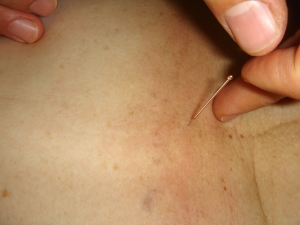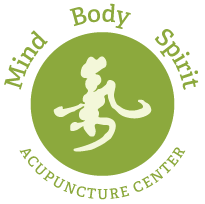Pain Management through Acupuncture
Increasingly, people are looking for more natural approaches to help relieve painful conditions instead of relying on medications. Pain management through Acupuncture can be helpful for all types of pain, regardless of what is causing the pain or where the pain is located. Some studies have shown the pain relief it provides can last for months.
Magnetic resonance imaging (MRI) of the brain before and after acupuncture treatment for pain shows dramatic decreases in brain activity — up to 70 percent. This decrease in brain activity in certain areas of the brain is thought to be the reason for the reduction of pain caused by the acupuncture treatments. In addition to reducing pain, acupuncture also hastens the healing process by increasing circulation and attracting white blood cells to an injured area.
The basis of acupuncture is expressed in this famous Chinese saying: “Bu tong ze tong, tong ze bu tong” which means “free flow: no pain, no free flow: pain.” In other words, any kind of pain or illness represents an obstruction in the normal flow of Qi or life force. Simply put, acupuncture moves Qi, restoring free flow.
Acupuncture has become readily accepted in mainstream modern medicine as a viable option for pain management and studies support its therapeutic effects.
In a German study, published in the Archives of Internal Medicine, 1,162 adults with chronic, lower back pain were divided into groups treated with either the standard pharmaceutical and exercise therapy commonly used in conventional medicine or acupuncture. The researchers reported that acupuncture provided relief and lasting benefits to nearly twice as many lower back pain patients as drugs and exercise. Forty-eight percent of the acupuncture patients reported at least a one-third decrease in pain along with improvement in their ability to function, versus 27 percent of the patients treated with conventional methods reporting such benefits.
Pain Management for Lower Back through Acupuncture
 Low back pain is an extremely common concern, affecting anywhere from 75 to 90 percent of people at some point in their lives. Low back pain is second only to the common cold as a cause of lost days at work and is one of the most common reasons to seek medical care, including acupuncture. In fact, one of the top reasons that people get acupuncture treatments is for low back pain management.
Low back pain is an extremely common concern, affecting anywhere from 75 to 90 percent of people at some point in their lives. Low back pain is second only to the common cold as a cause of lost days at work and is one of the most common reasons to seek medical care, including acupuncture. In fact, one of the top reasons that people get acupuncture treatments is for low back pain management.
In a study published in the Annals of Internal Medicine, researchers from the University of Maryland School of Medicine analyzed 33 studies covering more than 2,100 patients from around the world on acupuncture for low back pain.
They found acupuncture provided definite pain relief in the short-term (defined as relief sustained for three weeks after the end of the acupuncture sessions).
In spite of the large number of pathological conditions that can give rise to low back pain, up to 85 percent of the cases are classified by physicians as ‘non-specific’. When low back pain is examined from an Oriental medicine perspective, it is seen as a disruption to the flow of Qi within the area and associated with a specific disharmony and is treated accordingly.
The disruption of Qi that results in low back pain is usually associated with the following three disharmonies:
Weak Kidney Qi – In Oriental medicine, the lower back is referred to as the “dwelling of the kidneys”. The majority of chronic low back pain conditions are associated with kidney deficiency. Pain related to kidney deficiency is typically dull and erratic. It is usually aggravated by fatigue and improves with rest.
Stagnation of Qi and Blood – When the flow of Qi along the meridians that traverse the lumbar region becomes congested, it is referred to as the stagnation of Qi and blood. This presents with a severe stabbing pain that is worse with rest and better with movement, tender to touch, and can be accompanied by stiffness and tightness.
Invasion of Cold and Dampness – Cold, damp type pain is generally worse in the morning and when the weather is cold and damp. This type of pain improves with movement and the application of heat. Stiffness and contraction of back muscles that is aggravated by immobility indicates cold predominance. Swelling, numbness, and a heavy sensation are indicative of dampness.
Ah Shi Points
Not all acupuncture points have a specific name and specific location. Some of the most effective points to use in acupuncture are local points of tenderness. These points are referred to as Ah Shi points, which in Chinese literally means, “That’s the point!”
Ah Shi points were first mentioned during the Tang dynasty (founded in 618 AD) classic book Thousand Ducat Prescriptions. These points become spontaneously tender when disease or injury occurs, or in locations where Qi has become congested. They are not among the regular acupuncture points on a specific meridian or pathway.
Their locations are not fixed; they are the points that, upon palpation, are the most sensitive. In many cases, a small knot or pea-sized nodule can be felt under the skin at these points of tenderness.
The Ah Shi points are especially effective in the treatment of pain and are often used in conjunction with local and distal acupuncture points.
If you have pain, palpate around the area of pain to see if you can find the Ah Shi points. This is a great way to self-treat the problem.
Pain Management through Acupuncture can treat the following:
Back pain
Bursitis
Carpal Tunnel
Fibromyalgia
Hip pain
Joint pain
Leg pain / cramps
Neck stiffness / pain
Neuralgia
Sciatica
Shingles
Shoulder pain
Sport’s injury
Sprains / Strains
Tendonitis
Whiplash
Work-related / Auto-related injury

